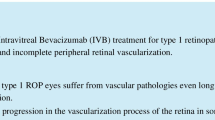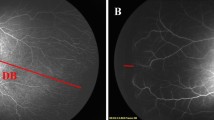Abstract
Purpose
To investigate the extent of vascularization of the peripheral retina and vascular development patterns in patients with type 1 retinopathy of prematurity (ROP) treated with intravitreal injection of bevacizumab (IVB) and compare fluorescein angiography (FA) findings of them to those seen in patients with type 2 ROP who have recovered spontaneously.
Methods
Between May 2014 and September 2016, patients with type 1 ROP who had a single 0.025 ml (0.625 mg) IVB were evaluated as study group. On the other hand, type 2 ROP patients with stage 2 or stage 3 ROP in zone II without plus disease on indirect ophthalmoscopy were not treated and included as a control group. The progression of ROP and vascularization of retina were evaluated by FA under sedation analgesia in all patients.
Results
Sixty-two eyes of 31 premature infants were included in the study: 36 eyes/18 patients were treated for type 1 ROP and 26 eyes/13 patients were followed conservatively with the diagnoses of type 2 ROP. In the last FA examination among the study group, vascular terminal was in zone II in 8 eyes/4 patients (22.22%) and in zone III in 28 eyes/14 patients (77.78%). Vascular terminal was in zone III in all eyes of the control group (100%). We noted circumferential vessels in 12 eyes/8 patients (33.3%) and 7 eyes/5 patients (26.92%) in the study and control groups, respectively. Abnormal branching was noticed in 13 eyes/7 patients (46.42%) in the control group, whereas it was not detected in the study group. Arteriovenous shunts were noted in 1 eye of a patient in the study group and in 5 eyes/4 patients in the control group. In 6 eyes/3 patients among the study group, we performed laser photocoagulation to the avascular retina because of profound vascular leakage.
Conclusion
Peripheral vascular abnormalities probably occur as a result of ROP itself because similar FA findings were detected both in type 1 and type 2 ROP patients with or without treatment, although significantly less in IVB-treated group. Retinal vascularization usually reaches the farthermost limits with time even though it slows down in eyes treated with IVB, indicating the importance of a longer follow-up.




Similar content being viewed by others
References
Stenkuller PG, Du L, Gilbert C, Foster A, Collins ML, Coats DK et al (1999) Childhood blindness. J AAPOS 3:26–32
Klufas MA, Chan RV (2015) Intravitreal anti-VEGF therapy as a treatment for retinopathy of prematurity: what we know after 7 years. J Pediatr Ophthalmol Strabismus 52:77–84
Wu WC, Lien R, Liao PJ, Wang NK, Chen YP, Chao AN, Chen KJ, Chen TL, Hwang YS, Lai CC (2015) Serum levels of vascular endothelial growth factor and related factors after intravitreous bevacizumab injection for retinopathy of prematurity. JAMA Ophthalmol 133:391–397
Zhou Y, Jiang Y, Bai Y, Wen J, Chen L (2016) Vascular endothelial growth factor plasma levels before and after treatment of retinopathy of prematurity with ranibizumab. Graefe’s Arch Clin Exp Ophthalmol 254:31–36
Pertl L, Steinwender G, Mayer C, Hausberger S, Pöschl EM, Wackernagel W, Wedrich A, El-Shabrawi Y, Haas A (2015) A systematic review and meta-analysis on the safety of vascular endothelial growth factor (VEGF) inhibitors for the treatment of retinopathy of prematurity. PLOS ONE 10(6):e0129383
Wang H, Yang Z, Jiang Y, Flannery J, Hammond S, Kafri T, Vemuri SK, Jones B, Hartnett ME (2014) Quantitative analyses of retinal vascular area and density after different methods to reduce VEGF in a rat model of retinopathy of prematurity. Investig Ophthalmol Vis Sci 55:737–744
Geisen P, Peterson LJ, Mariniuk D (2008) Neutralizing anti-body to VEGF reduces intravitreous neovascularization and may not interfere with ongoing intraretinal vascularization in a rat model of retinopathy of prematurity. Mol Vis 14:34557
Early Treatment for Retinopathy of Prematurity Cooperative Group (2003) Revised indications for the treatment of retinopathy of prematurity: results of the early treatment for retinopathy of prematurity randomized trial. Arch Ophthalmol 121:1684–1694
Lorenz B, Stieger K (2015) Retinopathy of prematurity recent developments in diagnosis and treatment. Expert Rev Ophthalmol 10:167–182
Kong L, Mintz-Hittner HA, Penland RL, Kretzer FL, Chevez-Barrios P (2008) Intravitreous bevacizumab as anti-vascular endothelial growth factor therapy for retinopathy of prematurity: a morphologic study. Arch Ophthalmol 126(8):1161–1163
Mintz-Hittner HA, Kennedy KA, Chuang AZ, the BEAT-ROP Cooperative Group (2011) Efficacy of intravitreal bevacizumab for stage 3 retinopathy of prematurity: preliminary results of the BEAT-ROP clinical trial. N Engl J Med 364:603–615
Tahija SG, Hersetyati R, Lam GC, Kusaka S, Mc Melamine PG (2014) Fluorescein angiographic observations of peripheral retinal vessel growth in infants after intravitreal injection of bevacizumab as sole therapy for zone I and posterior zone II retinopathy of prematurity. Br J Ophthalmol 98:507–512
Lalwani GA, Berrocal AM, Murray TG, Bruch M, Cardone S, Hess D, Johnson RA, Puliafito CA (2008) Off-label use of intravitreal bevacizumab (Avastin) for salvage treatment in progressive threshold retinopathy of prematurity. Retina 28:13–18
Mintz-Hittner HA, Kuffel RR Jr (2008) Intravitreal injection of bevacizumab (Avastin) for treatment of stage 3 retinopathy of prematurity in zone I or posterior zone II. Retina 28:831–838
Kusaka S, Shima C, Wada K, Arahori H, Shimojyo H, Sato T, Fujikado T (2008) Efficacy of intravitreal injection of bevacizumab for severe retinopathy of prematurity: a pilot study. Br J Ophthalmol 92:1450–1455
Martinez-Castellanos MA, Schwartz S, Hernandez-Rojas ML, Kon-Jara VA, Garcia-Aguirre G, Guerrero-Naranjo JL, Chan RV, Quiroz-Mercado H (2013) Long-term effect of antiangiogenic therapy for retinopathy of prematurity up to 5 years of follow-up. Retina 33:329–338
Lorenz B, Stieger K, Jager M, Mais C, Stieger S, Andrassi-Daida M (2017) Retinal vascular development with 0.312 mg intravitreal bevacizumab to treat severe posterior retinopathy of prematurity: a longitudinal fluorescein angiographic study. Retina 37:97–111
Wallace DK, Wu KY (2013) Current and future trends in treatment of severe retinopathy of prematurity. Clin Perinatol 40:297–310
Harder BC, Schlichtenbrede FC, von Baltz S, Jendritza B, Jonas JB (2013) Intravitreal bevacizumab for retinopathy of prematurity: refractive error results. Am J Ophthalmol 155:1119–1124
Geloneck MM, Chuang AZ, Clark WL, Hunt MG, Norman AA, Packwood EA, Tawansy KA, Mintz-Hittner HA, BEAT-ROP cooperative Group (2014) Refractive outcomes following bevacizumab monotherapy compared with conventional laser treatment: a randomized clinical trial. JAMA Ophthalmol 132:1327–1333
Chen Y-H, Chen S-N, Lien RI, Shih CP, Chao AN, Chen KJ, Hwang YS, Wang NK, Chen YP et al (2014) Refractive errors after the use of bevacizumab for the treatment of retinopathy of prematurity: 2-year outcomes. Eye 28:1080–1087
Mintz-hittner HA, Geloneck MM, Chuang AZ (2016) Clinical management of recurrent retinopathy of prematurity after intravitreal bevacizumab monotherapy. Ophthalmology 123:1845–1855
Selvam S, Kumar T, Fruttiger M (2018) Retinal vasculature development in health and disease. Prog Retin Eye Res 63:1–19
Garcia Gonzalez JM, Snyder L, Blair M, Rohr A, Shapiro M, Greenwald M (2018) Prophylactic peripheral laser and fluorescein angiography after bevacizumab for retinopathy of prematurity. Retina 38:764–772
Blair MP, Shapiro MJ, Hartnett ME (2012) Fluorescein angiography to estimate normal peripheral retinal nonperfusion in children. J Am Assoc Pediatr Ophthalmol Strabismus 16:234–237
Hu J, Blair MP, Shapiro MJ, Lichtenstein SJ, Galasso JM, Kapur R (2012) Reactivation of retinopathy of prematurity after bevacizumab injection. Arch Ophthalmol 130:1000–1006
Wong RK, Hubschman S, Tsui I (2015) Reactivation of retinopathy of prematurity after ranibizumab treatment. Retina 35:675–680
Isaac M, Mireskandari K, Tehrani N (2016) Does bevacizumab alter vascularization potential in retinopathy of prematurity? Ophthalmology 123:2042–2043
Lepore D, Quinn GE, Molle F, Orazi L, Baldascino A, Ji MH, Sammartino M, Sbaraglia F, Ricci D, Mercuri E (2018) Follow-up to age 4 years of treatment of type 1 retinopathy of prematurity intravitreal bevacizumab injection versus laser: fluorescein angiographic findings. Ophthalmology 125:218–226
Author information
Authors and Affiliations
Corresponding author
Ethics declarations
Conflict of interest
All authors certify that they have no affiliations with or involvement in any organization or entity with any financial interest (such as honoraria; educational grants; participation in speakers’ bureaus; membership, employment, consultancies, stock ownership, or other equity interest; and expert testimony or patent-licensing arrangements), or non-financial interest (such as personal or professional relationships, affiliations, knowledge, or beliefs) in the subject matter or materials discussed in this manuscript.
Ethical approval
All procedures performed in studies involving human participants were in accordance with the ethical standards of the institutional and/or national research committee (Dr. Sadi Konuk Bakirkoy EAH ethical committee) and with the 1964 Helsinki Declaration and its later amendments or comparable ethical standards. It is a retrospective study; therefore, formal consent is not required.
Informed consent
Informed consent was obtained from all individual participants’ parents in the study, as it is routinely done before all invasive procedure.
Rights and permissions
About this article
Cite this article
Vural, A., Ekinci, D.Y., Onur, I.U. et al. Comparison of fluorescein angiographic findings in type 1 and type 2 retinopathy of prematurity with intravitreal bevacizumab monotherapy and spontaneous regression. Int Ophthalmol 39, 2267–2274 (2019). https://doi.org/10.1007/s10792-018-01064-7
Received:
Accepted:
Published:
Issue Date:
DOI: https://doi.org/10.1007/s10792-018-01064-7




